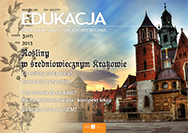Rośliny towarzyszące człowiekowi w średniowiecznym Krakowie
Plants accompanying of human in the medieval Kraków
Author(s): Marcin W. WochSubject(s): Agriculture, Energy and Environmental Studies, Human Ecology, 13th to 14th Centuries, 15th Century, Post-War period (1950 - 1989), Transformation Period (1990 - 2010)
Published by: Instytut Badań Edukacyjnych
Keywords: archaeobotanica; medieval Kraków; synanthropic plants;
Summary/Abstract: The history of human civilization is marked by accompaniment of specific plants. Their occurrence is strictly connected with economic processes and places disturbed by human. During a few archaeobotanical studies carried out in Kraków between years 1934 and 2001, many fruits and seeds of pant species were found in medieval layers dated to the 9–15th centuries A.D. They were mainly useful and synanthropic plants: weeds, ruderals and former cultivars or cultivars. These plants were dominated by weeds of cultivated crops characteristic of cornfields and flax fields and of root crops and gardens. Second types of debris are dominated by species characteristic of annual and biennial vegetation communities in ruderal habitats also thermophilic and heavily nitrophilous ruderal communities. Thanks to application of ecological characterization of individual synanthropic species and phytosociological analyses of ecological amplitudes of assemblages forming by them, it was possible to reconstruct environmental conditions ruling in medieval Kraków and location of several types of agricultures.
Journal: Edukacja Biologiczna i Środowiskowa
- Issue Year: 2013
- Issue No: 3
- Page Range: 3-9
- Page Count: 7
- Language: Polish
- Content File-PDF

